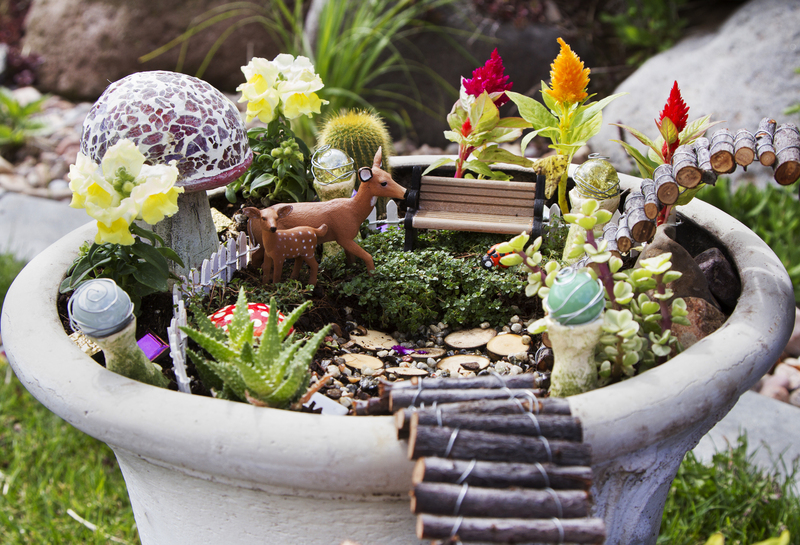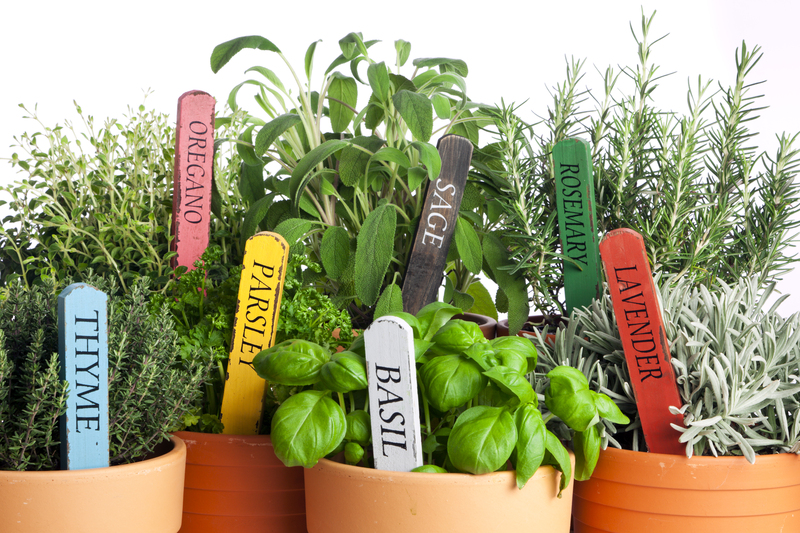Dog-Proof Your Garden with These Handy Tips
Posted on 30/08/2025
Dog-Proof Your Garden with These Handy Tips
For many pet owners, the garden is a cherished extension of their living space--a peaceful retreat, a lush haven for plants, and a safe place for beloved dogs to play. However, combining the needs of your four-legged friends with the demands of a thriving garden often seems like an endless battle. From dug-up flowerbeds to trampled vegetables and chewed-up shrubs, dogs can unintentionally wreak havoc on your beautiful backyard oasis. But fear not! With some strategic planning and the following expert guidance, you can dog-proof your garden and create a space that's both gorgeous and pet-safe.

Understanding the Challenges of Gardening with Dogs
Before you begin dog-proofing your garden, it's crucial to understand why dogs behave the way they do outdoors. Dogs are curious creatures with natural instincts to dig, sniff, explore, and sometimes chew. Certain breeds--such as terriers and retrievers--are especially energetic and prone to digging, while others may simply enjoy lying in cool, shaded soil. Recognizing your dog's individual behaviors will help you address specific problems.
Common Garden Problems Caused by Dogs
- Digging up plants and flowerbeds
- Chewing on shrubs, grass, or toxic plants
- Running rampant across vegetable patches and lawns
- Urinating on grass, causing yellow spots
- Leaving droppings in unwanted places
- Escaping through weak fences or gates
- Bringing dirt and mud into the home
Addressing these behaviors with a combination of training, landscaping, and canine-friendly design will help you dog-proof your garden efficiently.
1. Secure the Perimeter
Install a Dog-Safe Fence
The first and most critical step in making your garden dog-safe is to ensure there's a sturdy, secure perimeter. A high-quality fence will protect your dog from wandering off and keep unwanted animals out. Here are some important tips:
- Choose the right height and material: For most dogs, a fence at least 1.8 meters (6 feet) high is ideal. Use materials like wood, metal, or durable vinyl, avoiding chicken wire, which dogs can chew through or climb.
- Prevent digging at the base: Extend the fence underground by at least 12 inches. You can use concrete, gravel, or mesh buried alongside the fence to ensure your dog can't dig an escape route.
- Regularly check for weak spots or gaps and address them promptly.
Install Self-Closing Gates
Install self-closing or self-latching gates to prevent accidental escapes, especially if children play in the garden and may forget to close gates behind them.
2. Choose Dog-Friendly Plants and Replace Toxic Ones
Certain plants are toxic to dogs and can pose serious health risks if ingested. When dog-proofing your garden, it's essential to identify these hazards and select pet-safe alternatives.
Common Toxic Plants to Avoid
- Lilies
- Foxglove
- Oleander
- Daffodils
- Hydrangea
- Azaleas
- Yew
For a full guide, consult the ASPCA list of pet-toxic plants.
Dog-Safe Alternatives
Opt for robust, non-toxic, and hardy plants that can withstand a little roughhousing. Good choices include:
- Camellias
- Sunflowers
- Snapdragons
- Marigolds
- Bamboo
- Roses (avoid thorns for smaller dogs)
- Ornamental grasses
Pro Tip: Place fragile plants in raised beds or containers, keeping them out of reach from curious canines.
3. Designate a Dog Zone
Dogs thrive when they have their own special space. By creating a dog-friendly area in your garden, you can minimize the wear and tear on your favorite flowerbeds and veggie patches.
What to Include in a Canine Corner
- Digging pit: For dogs that love to dig, provide a dedicated digging area filled with sand or loose soil. Bury toys or treats to entice your dog and teach them where digging is allowed.
- Doghouse or shaded spot: Offer a comfortable, shaded place for your dog to rest and cool down, especially during warmer months.
- Durable toys: Keep your dog entertained in their designated area to reduce interest in the rest of the garden.
- Accessible water bowl: Hydration is crucial, particularly on hot days.
4. Create Protective Barriers for Fragile Plants
Physical barriers can be the most effective way to protect delicate plants and fragile flowers from trampling paws. Here are some useful ideas:
- Low fencing or edging: Short, decorative fences or border edging can keep dogs away from flowerbeds without obstructing your view.
- Raised beds: Planting in raised beds keeps flowers and vegetables out of easy reach, discouraging dogs from digging and running through them.
- Garden netting: Lightweight netting over new plantings will prevent your dog from disturbing young shoots.
5. Pave High-Traffic Areas
Dogs naturally follow the same routes through the garden, creating dog runs or worn paths over time. Instead of battling these tendencies, work with them:
- Install dog pathways: Use materials like gravel, paving stones, or bark chips on commonly used routes to make them durable and easy to clean.
- Plan your layout accordingly: Observe where your dog tends to run and design your paths to accommodate those patterns.
This strategy reduces mess and helps preserve your lawn and plant beds from excessive trampling.
6. Address Digging Behavior
Digging is often an instinctual behavior for dogs. While it can be difficult to stop entirely, the following tips can significantly minimize unwanted holes:
- Exercise your dog: A tired dog is less likely to dig out of boredom.
- Provide distractions: Leave plenty of toys, puzzle feeders, or chews to keep your dog occupied.
- Avoid scolding: Instead, redirect your dog to their designated digging area and reward them for using it.
- Citrus peels or coffee grounds: Some dogs dislike these scents; scatter them in restricted areas to deter digging (ensure no caffeine-rich grounds are left within reach).
7. Monitor and Limit Lawn Damage
Dog urine can leave brown or yellow spots on lawns due to its high nitrogen content. To protect your grass:
- Train your dog to use a specific potty spot: Designate an out-of-the-way area with gravel or mulch for bathroom breaks.
- Water the area after urination: Dilute the urine quickly to prevent burns.
- Use hard-wearing grass species: Ryegrass and fescues tolerate wear and recover more quickly.
- Consider artificial turf: In areas of heavy use, artificial grass may be more practical.
8. Keep Your Garden Free of Hazards
Aside from plants, gardens can contain other hidden dangers for dogs. Keep the following in mind:
- Secure garden chemicals: Store pesticides, fertilizers, and herbicides out of reach, and use only pet-safe alternatives wherever possible.
- Watch out for mulch: Cocoa mulch is toxic to dogs; choose pine, cedar, or untreated wood chips instead.
- Hide sharp tools: Always store garden tools in a locked shed.
- Pick up fallen fruit: Some fruits, like grapes, are toxic, and even safe varieties can upset your dog's stomach if overeaten.
9. Train and Supervise
The best way to dog-proof your garden is through consistent training and supervision. Reward your dog for positive behavior and redirect them from unwanted activities, especially in the early stages of establishing your garden.
- Positive reinforcement: Use treats or praise to reinforce good behavior in the garden.
- Supervise outdoor time: Especially with puppies or new garden layouts, supervise your dog until reliable habits are established.
- Consider obedience classes: Training courses can help iron out persistent bad habits and strengthen your bond with your pet.
10. Encourage Good Behavior with Enrichment
Enrichment is the secret to a happy, non-destructive dog. Providing mental stimulation and challenging activities discourages unwanted behaviors.
- Rotate toys regularly: Prevent boredom by switching up your dog's selection of outdoor toys.
- Interactive games: Try hide-and-seek with toys or treats, and play regular fetching games for exercise.
- Agility equipment: Install tunnels, jumps, or climbing platforms for dogs with energy to burn.

Frequently Asked Questions: Dog-Proofing Your Garden
What is the best fence to keep dogs out of flowerbeds?
A: Low, decorative fences made of metal or sturdy plastic, set at least 12 inches into the ground, provide an effective, attractive barrier for most dogs.
Which mulch is the safest for dogs?
A: Use cedar, pine, or untreated wood chips. Avoid cocoa mulch, as it is highly toxic to dogs.
What can I spray to keep dogs from digging?
A: Citrus-based sprays or white vinegar diluted in water may deter some dogs, but always test on a small area first and consult with your vet about safe repellents.
Are there lawn alternatives that hold up to dogs?
A: Hardy grass species like ryegrass and fescue, as well as artificial turf, are excellent options for gardens with active dogs.
Final Thoughts: Enjoy a Dog-Proof, Beautiful Garden
Dog-proofing your garden doesn't mean sacrificing beauty or comfort for either you or your pet. Through protective landscaping, smart plant selection, designated play zones, and effective training, your outdoor space can thrive even with the most rambunctious canine companions. A dog-friendly garden is a win-win: your plants flourish, and your dog stays happy and safe outdoors.
Implement these handy tips to transform your backyard into a secure, lush, and inviting garden--one that both you and your dog will love for years to come!
- Assess your dog's unique habits and needs before making changes.
- Use durable, pet-safe materials and plants for garden construction.
- Stay consistent with supervision and training for lasting results.
- Embrace the joys of a garden that's both beautiful and canine-approved!

